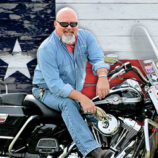I don’t much care for water, though I’ll admit that, properly prepared, it can be quite delicious. Proper preparation can involve either the addition of malted barley, hops and yeast, or the freezing of the stuff into little cubes dropped into a tumbler of Stoli, Clamato juice, Tabasco and horseradish. That makes the water delightfully palatable, but in its raw state, let’s face it, it’s pretty dreadful stuff.
So you can imagine my delight when recent medical studies were published putting the lie to old “eight-glasses-a-day” rule of thumb for water consumption preached ad nauseum by mothers and other health freaks for generations. Turns out there’s not a shred of evidence to support it, or to support claims that sucking down such prodigious quantities of water flushes out bodily toxins, or clears up your complexion, or suppresses appetite, or does much of anything besides load up your bladder.
Not that water’s utterly without value, mind you. Water’s a good solvent and a decent lubricant, it’s indispensible when boating, and it carved out the Grand Canyon, which earns it my grudging respect, but that’s about the extent of it. Still, there are times when drinking the straight stuff can be a good idea, and those times come while riding a bike in the sun-broil of summer when the heat wrings the moisture from your body like chamois at the car wash, and the wind-blast dissipates your sweat faster than you can produce it, sucking your body’s aquifer dry before you know it.
That plays hell with the old metabolism. Dehydration’s insidious effects include seriously impairing the muscle function and mental acuity that are critical to happy motoring. Running low on hydration will turn your limbs into linguini and your brain into something approximating a dried morel, and while that may sound like a lovely dish, it’s a recipe for disaster on the highway, and it’s absolutely essential that you replenish the aquifer at frequent intervals in those conditions.
I should point out at this juncture, since we’re being all scientific, that other recent studies have demonstrated that drinking beer is actually a superior means of quickly rehydrating after strenuous activity, compared to drinking either water or sports drinks. Seriously. As fun as it may sound to suck down a couple cold tall boys at every pit stop across the state of Nevada, though, there’s no denying that doing so comes with its own potentially disastrous side effects.
So fine. I’ve resigned myself to drinking straight water when I’m doing long spells of hot riding, but even that concession has brought a troubling downside with it since, like you, I’ve tended to do it by buying a bottle of water from the beverage case at the gas station when fueling up. That’s just how water gets consumed in this country these days. An entire mega-industry has grown up around the bottled-water phenomenon, one propelled in large measure by the mistaken presumption that bottled water is purer than the stuff coming out of the bathroom tap. That simply is not the case. The bottled water industry is virtually unregulated, and what little testing gets done on the actual quality of the water shows that it stacks up poorly in purity against the heavily regulated and tested public water supply. And for that you pay a buck or two a bottle. Sucker.
What’s even more depressing than that, however, is that the production, transport and disposal of those handy little plastic bottles are nothing short of an eco-disaster in progress. The petroleum wasted and the carbon generated in making and moving over 30 billion of those bottles a year in this country is staggering. Equally staggering is the sheer mass of nonbiodegradable plastic being plowed into landfills or carelessly chucked out to despoil roadsides and waterways, where they’ll remain intact for about a millennium.
Realizing all of this put me in a real pickle. It was bad enough that I had resigned myself to hydrating with straight water, but learning the alarming environmental impact of just grabbing a convenient bottled water was too much to bear. After agonizing over the predicament for some time, and preparing for a hot trot across the Mojave, a solution occurred to one—one that reached back to my Boy Scouting youth. Back then, I carried a collapsible cup when hiking and canoeing, dipping it into whatever stream or lake was available when I got thirsty. (Hard to believe now that there was time when you could do that in this country without getting poisoned, isn’t it?)
I bought a slick little collapsible cup that holds 12 ounces and tucks into my pocket along with the sunscreen stick and lip balm, giving me a sort of desert-rat survival kit, and it’s worked out brilliantly. I love this thing. At gas stations, instead of blowing money on a bottle of water, I slam a few cups of tap water from the bathroom and I’m good to go. Or if there’s a drinking fountain dispensing cool water, I use that, and the beauty of the cup in this instance is that drinking fountains, by and large, are diabolical devices that shoot out a feeble little stream of tantalizing water that you can’t get at with any satisfaction unless you have the mouth parts of an anteater. With my cup I can sup like a sultan.
The only downside I’ve been able to determine in this strategy is that if it’s too widely adopted by others, and the roadside is suddenly bare of discarded water bottles, then what will we use to transfer gas from our tank to that of our bone-headed bros who’ve run dry because they can’t read an idiot light? I need to think that one through. One thing’s for certain, though. They’re not using my collapsible cup.
It’s all right here in the diaries.


















